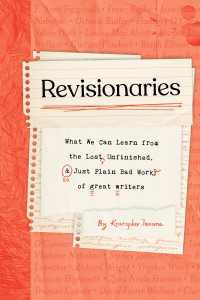Full Description
The Writer's World series was written to address the diverse needs of today's students: students whose first language is not English, students who respond favorably to visuals, and students who have varying skill levels.
Contents
PrefacePart I The Writing ProcessChapter 1 Exploring The Paragraph and the EssayVisualizing the Writing ProcessWhat is Exploring?TopicAudiencePurposeExploring StrategiesJournal and Portfolio WritingChapter 2 Developing What is Developing?Narrow the TopicThe Topic SentenceThe Supporting IdeasThe Paragraph PlanThe First DraftChapter 3 Revising and Editing What is Revising and Editing?Revise for UnityRevise for Adequate SupportRevise for CoherenceRevise for StyleEdit for ErrorsWrite the Final DraftPart II Paragraph PatternsChapter 4 Illustration What is Illustration?The Illustration ParagraphExplore TopicsThe Topic SentenceThe Supporting IdeasThe Paragraph PlanThe First DraftRevise and Edit an Illustration ParagraphChapter 5 Narration What is Narration?The Narrative ParagraphExplore TopicsThe Topic SentenceThe Paragraph PlanThe First DraftRevise and Edit a Narrative ParagraphChapter 6 Description What is Description?The Descriptive ParagraphExplore TopicsThe Topic SentenceThe Supporting IdeasThe Paragraph PlanThe First DraftRevise and Edit a Descriptive ParagraphChapter 7 Process What is a Process?The Process ParagraphExplore TopicsThe Topic SentenceThe Supporting IdeasThe Paragraph PlanThe First DraftRevise and Edit a Process ParagraphChapter 8 Definition What is Definition?The Definition ParagraphExplore TopicsThe Topic SentenceThe Supporting IdeasThe Paragraph PlanThe First DraftRevise and Edit a Definition ParagraphChapter 9 Classification What is Classification?The Classification ParagraphExplore TopicsThe Topic SentenceThe Supporting IdeasThe Paragraph PlanThe First DraftRevise and Edit a Classification ParagraphChapter 10 Comparison and Contrast What is Comparison and Contrast?The Comparison and Contrast ParagraphExplore TopicsThe Topic SentenceThe Supporting IdeasThe Paragraph PlanThe First DraftRevise and Edit a Comparison and Contrast ParagraphChapter 11 Cause and Effect What is Cause and Effect?The Cause and Effect ParagraphExplore TopicsThe Topic SentenceThe Supporting IdeasThe Paragraph PlanThe First DraftRevise and Edit a Cause and Effect ParagraphChapter 12 Argument What is Argument?The Argument ParagraphExplore TopicsThe Topic SentenceThe Supporting IdeasThe Paragraph PlanThe First DraftRevise and Edit an Argument ParagraphPart III The EssayChapter 13 Writing the Essay Explore TopicsThe Thesis StatementThe Supporting IdeasThe Essay PlanThe IntroductionThe ConclusionThe First DraftRevising and Editing the EssayThe Essay TitleThe Final DraftChapter 14 Essay Patterns The Illustration EssayThe Narrative EssayThe Descriptive EssayThe Process EssayThe Definition EssayThe Classification EssayThe Comparison and Contrast EssayThe Cause and Effect EssayThe Argument EssayChapter 15 Enhancing Your Writing with Research What is Research?Research for Academic WritingGathering InformationEvaluating SourcesAdd a Paraphrase, Summary, or QuotationCite Sources Using MLA StyleSample Research Essay Using MLA StylePart IV The Editing HandbookSection 1 Effective Sentences Section Theme Popular CultureChapter 16 Simple SentencesIdentify Prepositional PhrasesIdentify VerbsHelping VerbsChapter 17 Compound Sentences Compare Simple and Compound SentencesCombine Sentences Using Coordinating ConjunctionsCombine Sentences Using SemicolonsCombine Sentences Using Transitional ExpressionsChapter 18 Complex Sentences What is a Complex Sentence?Use Subordinating ConjunctionsUse Relative PronounsUse Embedded QuestionsChapter 19 Sentence VarietyWhat is Sentence Variety?Combine SentencesInclude a Question, a Quotation, or an ExclamationVary the Opening WordsCombine Sentences with a Present ParticipleCombine Sentences with a Past ParticipleCombine Sentences with an AppositiveSection 2 Common Sentence Errors Section Theme PSYCHOLOGYChapter 20 Fragments FragmentsChapter 21 Run-OnsRun-OnsChapter 22 Faulty Parallel Structure What is Parallel Structure?Identify Faulty Parallel StructureSection 3 Problems with Verbs Section Theme POLITICAL INTRIGUEChapter 23 Present and Past Tenses What is Verb Tense?The Simple Present TenseThe Simple Past TenseAvoid Double NegativesChapter 24 Past Participles Past ParticiplesThe Present Perfect Tense: have/has + Past ParticipleThe Past Perfect Tense: had + Past ParticipleThe Passive Voice: be + Past ParticipleChapter 25 Other Verb Forms Problems with Progressive Forms (-ing Verbs)Nonstandard Forms: gonna, gotta, wannaProblems with Conditional FormsNonstandard Forms: would of, could of, should ofSection 4 Verb Agreement and Consistency Section Theme COLLEGE LIFE Chapter 26 Subject-Verb Agreement Basic Subject-Verb Agreement RulesMore Than One SubjectSpecial Subject FormsVerb Before the SubjectInterrupting Words and PhrasesChapter 27 Tense Consistency Consistent Verb Tense Section 5 More Parts of Speech Section Theme INVENTIONS AND DISCOVERIESChapter 28 Nouns, Determiners, and PrepositionsSingular and Plural NounsCount Nouns and Noncount NounsDeterminersPrepositionsChapter 29 Pronouns Pronoun CaseRelative Pronouns (who, whom, which, that, whose)Reflexive Pronouns (-self/ -selves)Pronoun-Antecedent AgreementIndefinite PronounsVague PronounsPronoun ShiftsSection 6 Modifiers Section Theme HEALTH CARE Chapter 30 Adjectives and Adverbs AdjectivesAdverbsComparative and Superlative FormsChapter 31 Mistakes and Modifiers Misplaced ModifiersDangling ModifiersSection 7 Word Use and Spelling Section Theme THE LEGAL WORLD Chapter 32 Exact Language Use Specific and Detailed VocabularyAvoid Wordiness ad RedundancyAvoid ClichesStandard English Versus SlangChapter 33 Spelling and Commonly Confused WordsSpelling Rules120 Commonly Misspelled WordsLook-Alike and Sound-Alike WordsSection 8 Punctuation and Mechanics Section Theme THE WORKPLACE Chapter 34 CommasWhat Is a Comma?Commas in a SeriesCommas After Introductory Words and PhrasesCommas Around Interrupting Words and PhrasesCommas in Compound SentencesCommas in Complex SentencesCommas in Business LettersChapter 35 The Apostrophe, Quotation Marks, and TitlesThe ApostropheQuotation MarksPunctuation of TitlesChapter 36 Capitalization and Other Punctuation MarksCapitalizationOther Punctuation MarksSection 9 Editing Chapter 37 Editing Paragraphs and EssaysPart V Reading Strategies and SelectionsChapter 38 From Reading to WritingReading StrategiesReading Selections








